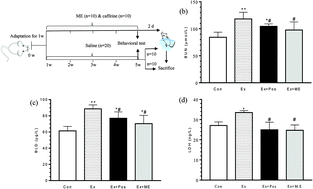Anti-fatigue effect of Lepidium meyenii Walp. (Maca) on preventing mitochondria-mediated muscle damage and oxidative stress in vivo and vitro†
Abstract
Maca (Lepidium meyenii Walp.) has emerged as a popular functional plant food due to its various pharmacological properties, including anti-oxidation, anti-inflammation and anti-fatigue activity. In this study, we investigated the role of Maca aqueous extract (ME) on muscle during exercise-induced fatigue both in vivo and in vitro. As a result, ME significantly enhanced mouse leg grip-strength and increased exercise endurance in the rota-rod test. ME could clear the accumulation of metabolites – blood lactic acid (BLA), blood urea nitrogen (BUN) and reactive oxygen species (ROS) levels after weight-loaded forced swimming. Focusing on muscle, we found that the administration of ME strengthened mouse muscle structures so that exercise-induced metabolic stress was alleviated by upregulating NAD+/NADH. Furthermore, ME inhibited the reduction of the viability and accumulation of ROS by treatment with H2O2 in C2C12 skeletal muscle cells. ME-induced activation of energy metabolism in skeletal muscle might up-regulate mitochondrial biogenesis and function, thereby protecting against oxidative stress-induced damage. We concluded that the effects of Maca played a crucial role in the regulation of exercise-induced fatigue in mouse muscle, which could be expected to serve as a functional food supplement for improving exercise performance and alleviating physical fatigue.



 Please wait while we load your content...
Please wait while we load your content...